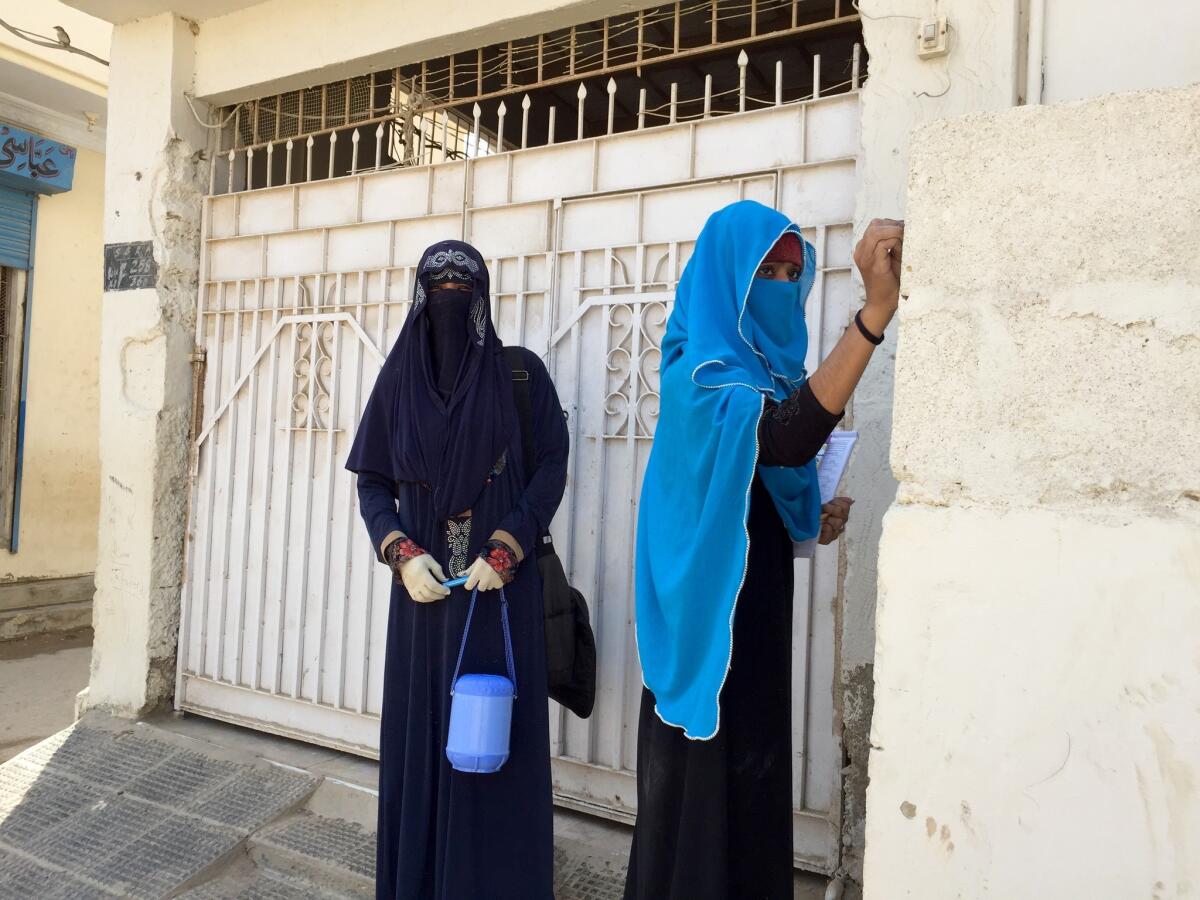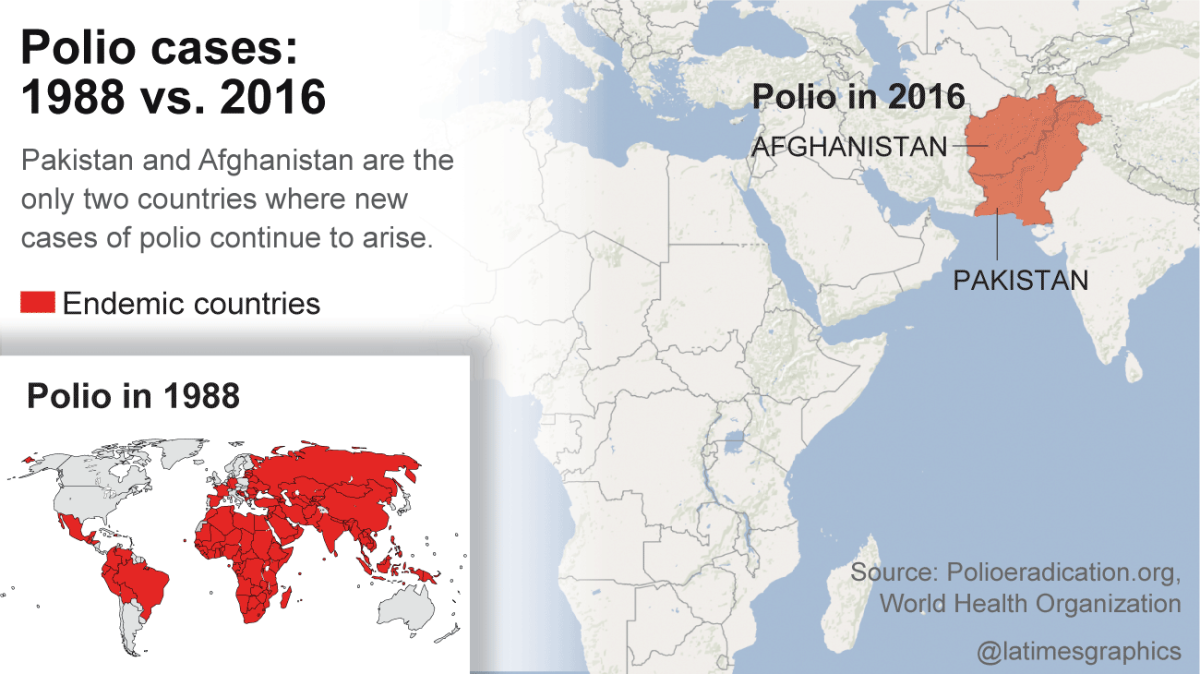Meet the women trying to rid Pakistan — and the world — of polio
Her slender hand sheathed in a black glove, Saira Nizamuddin gathered the fabric of her full-length abaya as she stepped across an alley strewn with rocks and trash.
The 19-year-old health worker walked alone, the mid-morning sun pressing down on the dirt streets and soaking into the black fabric covering her from head to toe. It was better this way, she thought. In the past, for security reasons, police officers had followed her as she visited houses to administer the polio vaccine to children.
Now, she and 10 vaccinators, all local women, were working unguarded. The low-profile approach was meant to assuage fears in their community that the vaccine was unsafe, forbidden by Islam or a cover for Western espionage — myths that have given the crippling virus, eradicated nearly everywhere else in the world, a lifeline in conservative Pakistan.

“This is my neighborhood,” Nizamuddin said. “We’re fine without the police.”
On the third day of a weeklong anti-polio drive last month in Karachi, a sprawling seaside metropolis, Nizamuddin turned left down an unmarked road. Two colleagues were waiting outside a residence. A metal gate opened slightly, and the women slipped inside.
Two hours later, however, the campaign was suspended across the city. Nizamuddin and her team were instructed to go home immediately. A few miles away, in a rough-and-tumble district called Orangi Town, seven police officers providing security for a polio team had been shot to death by gunmen riding motorcycles.
Pakistan’s long struggle against the disease was interrupted once again.
The militant violence that has claimed tens of thousands of Pakistani lives in the past decade also has stood in the way of a multibillion-dollar global campaign to wipe out what once was among the world’s most feared afflictions.
From 1988, when the world reported more than 350,000 new polio cases, the number dropped to just 74 last year: 54 in Pakistan, the rest in Afghanistan. Those are the only countries where the virus hangs on, finding sanctuary in the remote, mountainous border region and in the open sewers of hot, crowded neighborhoods in Karachi, a melting pot of 22 million-plus inhabitants.
India was declared polio-free in 2014, five years after it accounted for half the cases in the world. Nigeria, formerly a reservoir for the disease in Africa, hasn’t reported a new case in nearly two years.

“It feels like all the fingers are pointing at us,” said Aziz Memon, chairman of Rotary International’s PolioPlus campaign in Pakistan.
Polio invades the central nervous system, can trigger life-threatening paralysis and is easily transmitted between humans in places with poor sanitation. There is no cure, but the virus can be eliminated from a population through mass immunizations. In the United States, that has meant injecting young children with the vaccine introduced by Jonas Salk in the 1950s.
But in countries like Pakistan, where children are more vulnerable to infections and there are fewer trained health workers, community-wide resistance to the disease has been improved with a less-expensive oral vaccine — a couple of drops on a child’s tongue, administered multiple times before age 5.
Workers go door-to-door throughout the year in an effort to reach every child, a painstaking mission underwritten by international donors at a cost of $1 billion every year. The U.S. has spent more than $1.3 billion on global anti-polio efforts since 2009.
But health officials and international experts think Pakistan could finally stop the spread of the disease this year. One of their reasons for optimism is people like Nizamuddin, who is part of a new strategy to employ local women to administer the vaccine and make regular house visits in some of the highest risk areas.
That includes her neighborhood in Gulshan, a warren of low-slung concrete blocks in eastern Karachi that is home to a large population of migrants from the Afghan border region, and the remote province of Baluchistan, both polio hotbeds. A 17-month-old boy was diagnosed with the virus here in December, the seventh case in the city last year.
Reports said the boy’s family had refused the vaccine. For years, Pakistani Taliban militants waged a propaganda war against the immunizations, describing them as a Western plot to sterilize Muslims and issuing a fatwa, or religious decree, against female health workers.
In 2012, militant leaders in the border area banned vaccinations in protest of U.S. drone strikes, leaving half a million children out of reach. The same year, immunization teams came under attack after it emerged that the CIA previously had enlisted a Pakistani doctor to snoop on Osama bin Laden’s hideout using the cover of a fake anti-hepatitis campaign.
Attacks blamed on extremists since have killed more than 100 health workers and security forces assigned to protect them. Male vaccinators in particular were suspected as spies, making them reluctant to travel without escort.
“People would ask me, ‘Are you a real health worker or a fake one?’ ” recalled Nizamuddin, who has worked on polio drives for four years. “Or parents would refuse on religious grounds.”
From 2012, when Pakistan recorded just 58 new polio cases — and none in Karachi — the number jumped to 306 in 2014, by far the most of any country.
Over the past two years, a security crackdown against militants in the border area and inside Karachi has allowed polio workers back into many former no-go zones. By late 2015, only about 30,000 children remained inaccessible, and transmission had slowed considerably: In the first four months of this year, Pakistan saw eight new polio cases, down from 22 over the same period in 2015.
But the Global Polio Eradication Initiative’s Independent Monitoring Board warned that without successful vaccination campaigns this spring, the disease would reemerge in the heat of summer.
“We were very close in the last decade,” said Memon, the PolioPlus campaign chairman in Pakistan. “This time, we hope we’re not going to miss the opportunity.”
We were very close in the last decade. This time, we hope we’re not going to miss the opportunity.
— Aziz Memon, chairman of Rotary International’s PolioPlus campaign in Pakistan
From the parking lot of a spartan government health clinic in Gulshan, pairs of female health workers, covered from head to toe in headscarves and black abayas, set off into the neighborhood carrying vials of polio vaccines in unmarked thermos bottles.
Three paramilitary Rangers in drab uniforms watched from a parked pickup, then drove off to patrol the periphery of the neighborhood. The women didn’t see them again for hours.
“There’s no need for security,” said Sikander Ali, a local health department official, who added that the presence of gun-toting police often scared residents. “People view the female health workers as locals.”
In the monochrome crowd, Nizamuddin, a team leader, stood out with a glittery blue headband, oversized purple watch and yellow trousers peeking out from under her abaya.
She comes from a family of polio workers. Her two elder sisters volunteered until they got married; her mother worked for eight years until she had to drop out this year because she couldn’t read, and the World Health Organization sought to recruit more educated women.
“She feels bad,” Nizamuddin said of her mother. “But she is happy that I can still help the cause.”
The WHO increased funding for female health workers, who earn full-time salaries of $150 a month. Attendance and morale have improved over the earlier system, which employed part-timers, including men, whose $5 daily wages were paid by the government, and often delayed.
“The men weren’t as dedicated,” Nizamuddin said. “And families used to refuse male workers. The interaction we have is totally different.”
One of her team members, Nagma, a mother of four, said few families reject the immunizations now. In one case, she persuaded a reluctant mother to allow the vaccine to be given by showing her cellphone pictures of her own children, who had been vaccinated multiple times.
In more difficult cases, the women called on Surat Khan Osman, a genial local cleric with a black beard that shone like lacquer and a battered cellphone that flashed with text messages notifying him of families who declined vaccinations.
Officials say clerics have become key partners. That morning, Osman and a team of female vaccinators visited two houses where parents claimed the vaccine would cause infertility. He won them over with a copy of a 2014 fatwa from religious scholars that said the vaccine was “fully permissible” under Islamic law and that parents were obligated to protect their children from polio.
“We are part of the community,” Osman said, “so people cannot refuse us.”

The morning after last month's shooting death of the officers, shaken health workers resumed the drive across the city. Rangers beefed up their presence in some areas; plainclothes security forces shadowed teams in others.
In Nizamuddin’s neighborhood of Sachal Goth, the women opted for an even lower profile. They avoided being seen in groups and varied their schedules. For the rest of the week, they tried to complete their rounds before lunch.
By week’s end, the teams in Sachal Goth inoculated 2,117 children — two dozen more than had been counted in a pre-campaign survey days earlier. One of Nizamuddin’s teams found a child whose family was visiting from outside the city and wasn’t on their list, but took the opportunity to administer the polio drops because he was scheduled to be vaccinated.
The female teams are now covering nearly 40% of Karachi’s 2.2 million children younger than 5, and the initiative soon could be expanded further. International officials describe its success as part of an overall improvement in Pakistan’s management of the crisis.
“The results are very promising,” said Huma Khan, a UNICEF polio specialist who has worked in the field for seven years. “It looks like we’re getting close to eradication. I’ve never been so hopeful that this can be done."
For more news on global sustainability, go to our Global Development Watch page.
Follow @SBengali on Twitter for more news from South Asia
Sign up for Essential California
The most important California stories and recommendations in your inbox every morning.
You may occasionally receive promotional content from the Los Angeles Times.








